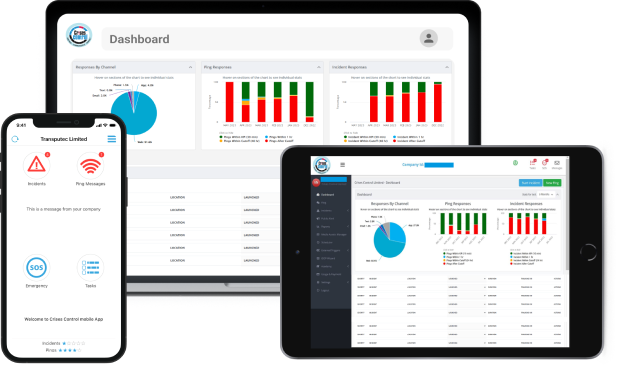Written by Anneri Fourie | Crises Control Executive
When speed and clarity matter, Emergency Notification Software makes all the difference.
You’re sitting at your desk. A colleague rushes in to say the company website has gone offline. Customer services are flooded with calls. No one’s sure what to do next. Within five minutes, the IT team is guessing. Within ten, your leadership team is asking why no one has been updated.
This is what a communication failure looks like in real life. It doesn’t have to be dramatic. It’s often slow, silent, and confusing. Messages get buried. People don’t reply. Others never even receive them. The result? Delays, panic, and damage that could have been avoided.
The solution isn’t just another chat app. What you need is a tool that cuts through the noise and tells the right people what’s happening and what they need to do, now. That’s exactly what Crises Control’s emergency notification software delivers, especially when it’s integrated directly into Microsoft Teams.
Microsoft Teams is useful, but not built for crisis communication
There’s no doubt Microsoft Teams has become the default collaboration tool for many businesses. It’s reliable, familiar, and flexible. But it wasn’t designed to handle urgent, high-stakes situations where clarity and speed are essential.
Let’s be honest. During a crisis:
- Teams channels can be noisy and cluttered
- There’s no clear way to confirm who’s seen your message
- You can’t track responses or escalate issues automatically
- You have to jump between apps to send updates across channels
That’s where Crises Control makes a difference. It enhances Microsoft Teams with mass communication capabilities designed specifically for emergencies. So instead of working around the limitations, you take control, using a platform your people already know.
What emergency notification software should really do
Emergency notification software isn’t just about pushing messages. It’s about coordination. It should help you communicate faster, make decisions quicker, and keep everyone focused on what matters.
Crises Control integrates directly into Microsoft Teams and gives you the ability to:
Reach everyone, everywhere
Send alerts simultaneously across Teams, SMS, email, mobile push, voice calls and web portals. If Teams is down, your message still gets through.
Target the right people
Use geolocation to send alerts to specific regions or sites. Notify only those who need to act, without overloading the rest of the organisation.
Track delivery and responses
Know exactly who has received, read and acknowledged each message. Escalate automatically if there’s no response.
Launch pre-planned responses
Use playbooks that trigger specific actions for different types of incidents, whether it’s a power failure, cyberattack or physical threat.
Keep a full record
Every step is recorded in real time, creating a detailed audit trail for post-incident reviews or compliance reporting.
This isn’t a basic Teams plugin or chatbot. It’s a purpose-built, enterprise-grade system that fits into the platform your team already uses.
Already a Crises Control Customer?
Common situations where every minute counts
Emergency notification software isn’t just about major disasters. It’s designed to help you stay in control of smaller, everyday disruptions too. Here are some real-world situations where Crises Control makes a difference:
Cybersecurity incidents
When a breach is detected, you don’t have time to manually type out a plan. Crises Control triggers a pre-configured response: your IT team is alerted, leadership is notified, and employees receive guidance, all within seconds.
Severe weather
Flood warnings, snow, storms, these events don’t just affect staff safety; they impact operations and logistics. With geo-targeted alerts, you can inform only those affected and offer clear instructions about closures or remote work.
Equipment or network failure
If your systems go down, every minute of delay costs money. Crises Control lets you inform engineers, shift leads and managers immediately, while tracking their acknowledgements and next steps.
Healthcare or public sector alerts
Hospitals and councils often need to alert teams quickly during service disruptions or health alerts. Crises Control provides structured, reliable communication without relying on scattered WhatsApp groups or generic emails.
Transport and logistics
Road closures, last-minute changes to delivery routes, or warehouse incidents can create huge knock-on effects. A quick, targeted alert to drivers or on-site managers helps avoid confusion and delay.
From fragmented messages to coordinated response
Let’s take a step back. Here’s how most organisations handle a crisis without emergency notification software:
- Someone sends an email or Teams message
- They follow up with a phone call
- Another team sends a WhatsApp message
- Managers start asking for updates in a separate thread
- No one is sure what’s already been said or who has been contacted
This is how time gets wasted and mistakes happen.
With Crises Control, you manage everything from a single system. Your messages are clear. You can see who has received them. You don’t have to chase or guess. And your teams get the information they need, without confusion.
Simple enough for anyone to use, even under pressure
A tool is only useful if people actually use it. And in a crisis, simplicity is key.
Crises Control is designed to be intuitive. The interface is clean and easy to navigate, whether you’re at a desk or on your phone. Different teams can be assigned different roles and access levels, so people only see what’s relevant to them.
And because it’s embedded inside Microsoft Teams, there’s no new platform to learn. Your employees continue using what they already know, while Crises Control handles the heavy lifting in the background.
What businesses gain from better crisis communication
Buying emergency notification software isn’t just about managing disasters. It’s about reducing risk, saving time, and protecting your people and your reputation.
Companies using Crises Control have reported:
- A reduction in response times by up to 80%
- Better coordination between teams across multiple sites
- Easier compliance with internal and external reporting standards
- Higher employee confidence during incidents
- Fewer missed communications and errors
In practical terms, this means fewer delays, faster recovery, and a stronger reputation for control and professionalism.
Add structure, speed and confidence to your emergency response
Crises Control is more than a messaging tool. It helps you:
- Prepare with custom scenarios and response plans
- Respond with automated alerts and clear steps
- Review with full audit logs and analytics
Every message is tracked. Every action is logged. And every second saved gives your teams a better chance to act effectively.
Whether you’re managing physical safety, cybersecurity threats or operational disruptions, Crises Control gives you a structured, repeatable way to stay ahead.
Microsoft Teams + Crises Control: A smarter way to stay connected in a crisis
If you’re already using Microsoft Teams, you’ve got a powerful collaboration tool at your fingertips. But collaboration and crisis management aren’t the same thing.
By adding Crises Control, you transform Teams into a central emergency coordination hub. You get structured, reliable communication that doesn’t get lost in busy threads or forgotten inboxes. You reach people faster. You make decisions quicker. And you stay in control, even when everything else is uncertain.
See it for yourself
The best way to understand the value of emergency notification software is to see it in action.
Get in touch today to request a free demo. We’ll show you how Crises Control integrates with Microsoft Teams, how it fits into your existing processes, and how it can help you prepare for whatever comes next.
Don’t leave your crisis communication to chance. Crises Control helps you act quickly, communicate clearly, and recover with confidence.
Request a FREE Demo

